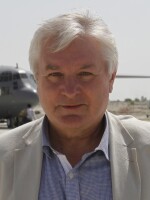SCOTT SIMON, host:
This is WEEKEND EDITION from NPR News. I'm Scott Simon.
(Soundbite of mass protesters in Nepal)
Security forces in Nepal today opened fire on demonstrators who were marching toward the Royal Palace in Katmandu. Several people were wounded and dozens of others were injured by police who were yielding bamboo batons. The violence erupted as opposition leaders rejected an announcement from King Gyanendra that he will ask the seven political parties there to choose a prime minister and form a new government.
NPR's Philip Reeves was in the middle of the demonstrations today. He joins us from Katmandu. Philip, thanks for being with us.
PHILIP REEVES reporting:
You're welcome.
SIMON: What did you see?
REEVES: Well, I was one of a crowd of thousands of people who were in a very confident, very assertive and not a particularly violent mood that gathered in a western suburb of the city. They were waving banners, they were brandishing branches of trees, chanting slogans against the King and in favor of democracy. And then they began to walk towards the city itself, into the area that is under curfew. There were thousands of people on the balconies abiding by the curfew who were watching them as they processed down the streets.
The police made several attempts to form a line and block them but melted away or rather withdrew. And behind the police lines were phalanxes of soldiers with automatic weapons. We walked for several miles. The crowd carried on singing and waving and clapping and went well into the curfew zone.
SIMON: Phil, what does the opposition not accept about King Gyanendra's offer, the form -- to have the seven political parties form a new government?
REEVES: Well, talking to the people in the crowd, they were saying that what they want is a constituent assembly which will create a new constitution. They say they want the King only to have only at best a ceremonial status. They want the army to be placed under the control of a civilian government. The Nepalese Army has a record of committing a number of atrocities, particularly in relation to the Maoist insurgency that's been raging here for 10 years. And they also want a government that's going to be inclusive in some way of the Maoists. They are tired of having war in this country, but at the same time, they're defiant.
It was clear that some in the crowd believe that if the King doesn't make any more concessions to them, then the monarchy will have to go. For example, I spoke to a graphic designer called Deporsestra(ph), and this is what he had to say.
DEPORSESTRA (Protestor, Katmandu): This is absolutely the last chance for the King to bow down the presence of the people. If he don't even try to give up his power and listen to the voice of his people then he's gone. He's a little bit of the history. (Unintelligible).
REEVES: And there were plenty of other people, Scott, who echoed that sentiment, a sentiment which I suspect has become harder after the violence that took place during these demonstrations today.
SIMON: What other activities are going on in the capitol? I'm assuming meetings, demonstrations, that sort of thing?
REEVES: Mobile phones have been cut off here because the government's keen to try to restrict these demonstrations against the King. So it's hard getting a picture. But reports are saying that about 100,000 people were on the streets and that in two places, as they pushed towards the city center, which is of course where the palace is, the police fired rubber bullets on them, they fired tear gas. We are also getting reports that live ammunition was used and four people were injured by gunfire.
I went to a hospital and saw 34 injured people, two of whom were injured with rubber bullets, one of whom was critically injured, apparently having been beaten up by police wielding sticks.
SIMON: NPR's Philip Reeves in Katmandu. Thanks very much.
REEVES: You're welcome. Transcript provided by NPR, Copyright NPR.








